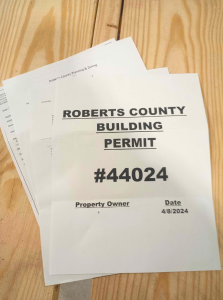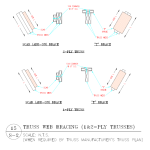 Yesterday I covered 7 of what I feel are 14 of the most important questions to ask your local building department. This not only will smooth the way through the permitting process, but also ensures a solid and safe building structure.
Yesterday I covered 7 of what I feel are 14 of the most important questions to ask your local building department. This not only will smooth the way through the permitting process, but also ensures a solid and safe building structure.
Let’s talk about the last seven….
#8 What is the Allowable Soil Bearing Capacity?
This will be a value in psf (pounds per square foot). If in doubt, err on the side of caution. As a rough rule – the easier the soil is to dig in, the weaker it will be in supporting a building. A new pole building is only as solid as the foundation upon which it is built, and the foundation is only as strong as the soil it rests upon.
Some jurisdictions (most noticeably in California and Colorado) will require a soils (geotechnical) engineer to provide an engineered soil report, which spells out the actual tested strength of the soil. Other states may have requirements as well, so be sure to ask ahead of time.
#9 Is an engineered soils test required?
If so, get it done ahead of time. Don’t wait. It’s easy to do and there are plenty of soil engineers out there.
#10 What is your Seismic Category (such as A, B, C, D-1, D-2)?
While rarely do potential seismic forces dictate the design of a pole building, there are instances where they can. A high seismic potential, with high flat roof snow load and low wind load is one case. The other situation is when you are considering a multiple story structure.
#11 Are wet-stamped engineer signed and sealed structural plans required to acquire a permit?
Some Building Department Officials will say no to this, yet during the plans review process they request structural engineering calculations to prove the design, or (worse yet) they make wholesale changes to plans, based upon the way they think a pole building should be constructed.
My recommendation – invest in engineered plans. In the end, it is assurance a registered design professional has verified the building will meet the loading requirements. In some cases, insurance companies offer discounts on buildings which have been designed by an engineer. It’s certainly worth asking for one!
In some cases, Building Permits will be granted with only requiring engineer sealed truss drawings.
Are exterior finished (showing roofing and siding) elevations required with the building plans-;o? Will more than two sets of drawings be needed for permit submittal?
#12 Verify the Building Occupancy.
Most buildings which are not frequently occupied by the public (not a home, business or municipal building) represent a low hazard to human life in the event of a failure and are ASCE (American Society of Civil Engineers) Category I. This information can be found by the Building Official in IBC/IRC Table 1604.5 and is not to be confused with the Use and Occupancy classifications from Chapter 3 of the Code.
#13 In areas with cold winters, is the frost depth greater than 40”?
All building columns or foundations must extend below the frost line to prevent heave. We don’t design for any depth less than 40”, and have designed for up to 7 feet deep in some areas!
#14 Does the Department have any unusual Building Code interpretations, amendments or prescriptive requirements for non-engineered buildings which could affect this building?
If so, get a copy from your building department for us, or anyone else whom might be considered to be a provider for your building project.
Even though “the Code is The Code”, there are a plethora of local folks who think they have better ways or better ideas than the smartest structural minds in the world, who have actually written the Code. And once again, I can’t stress enough: get your plans sealed by an engineer. It will make life easier all around when it comes to getting your permit, even if you have been told seals are “not required”.
No one outside of a permit office wants the construction process to be any more difficult or challenging than necessary. Being armed with the correct information (after doing the homework of course) is a solid step in the right direction.









